Canada makes up almost all of the northern portion of North America. Three oceans border this large country; the Pacific Ocean in the west, the Arctic Ocean to the north, and the Atlantic Ocean in the east. These three oceans are the lifeline to millions of different species, including fish, shellfish, waterfowl, invertebrates, turtles, and mammals. Sharks are some of the biggest animals you can find on Canada’s coast, with some being massive in size.
Scientists have estimated around 90% of species in the ocean are still undiscovered. With such a wide variety of sea life, there are bound to be variations in their sizes as well. Other big creatures found in the sea are whales, squid, jellyfish, and octopuses.
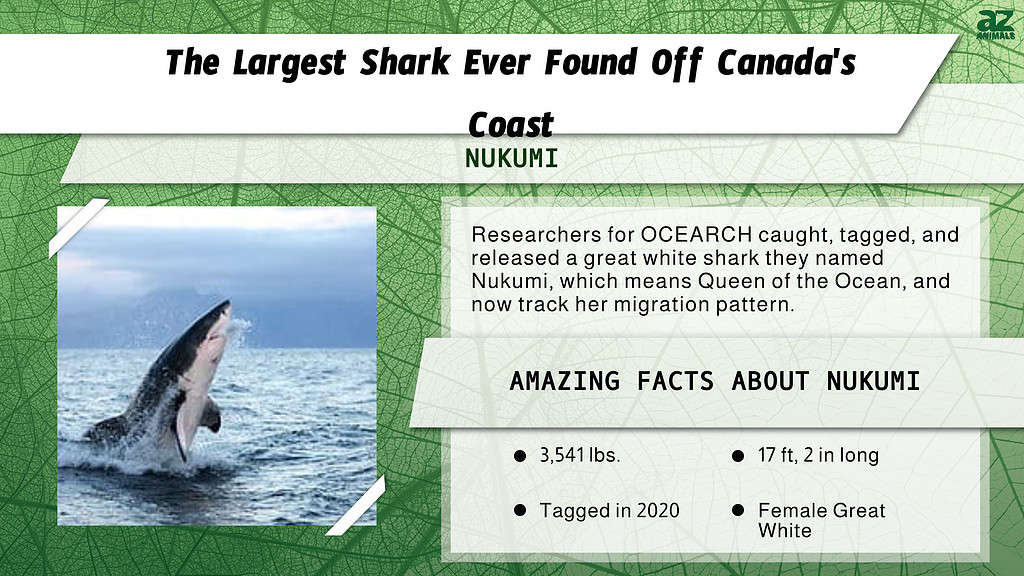
What is the Biggest Shark Ever Found Off Canada’s Coast?
In recent years shark sightings have become more common in Canada. The most commonly seen shark is the great white, and these sharks are most often found in the cold waters of the Atlantic and the Pacific oceans.
In October 2020, a team of researchers dedicated to tracking great whites in the Atlantic Ocean caught and tagged a very large female great white. This shark measured 17 feet 2 inches (5.2 meters) long and weighed 3,541 pounds (1606.1 kg). They reported that she is the largest shark they’ve tagged in the North Atlantic. After being safely caught and tagged, she was named Nukumi or “Queen of the Ocean” and released back into the water.
The researchers who found the “Queen of the Ocean” work for an organization named OCEARCH. They have caught and tagged dozens of sharks during their expedition. These tags relay information to OCEARCH’s dedicated website, where they track other sharks like Nukumi to allow them to find and chart their migration patterns.
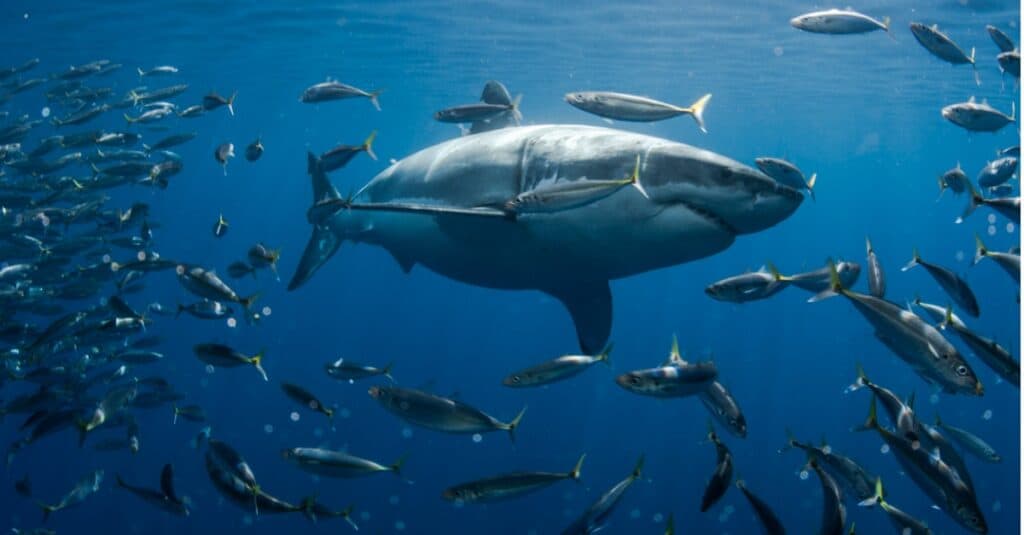
Great white sharks eat seals, sea lions, dolphins, and fish, among other animals.
©iStock.com/atese
Are Great White Sharks Dangerous?
Great white sharks are predatory fish descended from the largest known predator in the ocean, the megalodon. There have reportedly been 333 attacks by great white sharks worldwide, with 52 attacks resulting in fatalities, and great white sharks attack unprovoked more than any other shark.
While great white sharks are dangerous and should be avoided, if encountered, it is very unlikely you’ll be attacked by one. Canada’s coast hasn’t seen a shark attack since 1870 and is not likely going to see any anytime soon. The only things great whites pose a real threat to are fish and sea mammals like seals and sea lions which are their main prey.
Sharks often come near the coast if they think they’ll get some food. If there’s deep enough water, a shark will likely swim by searching for a meal. Attacks on humans usually occur in around 10 to 30 feet of water.
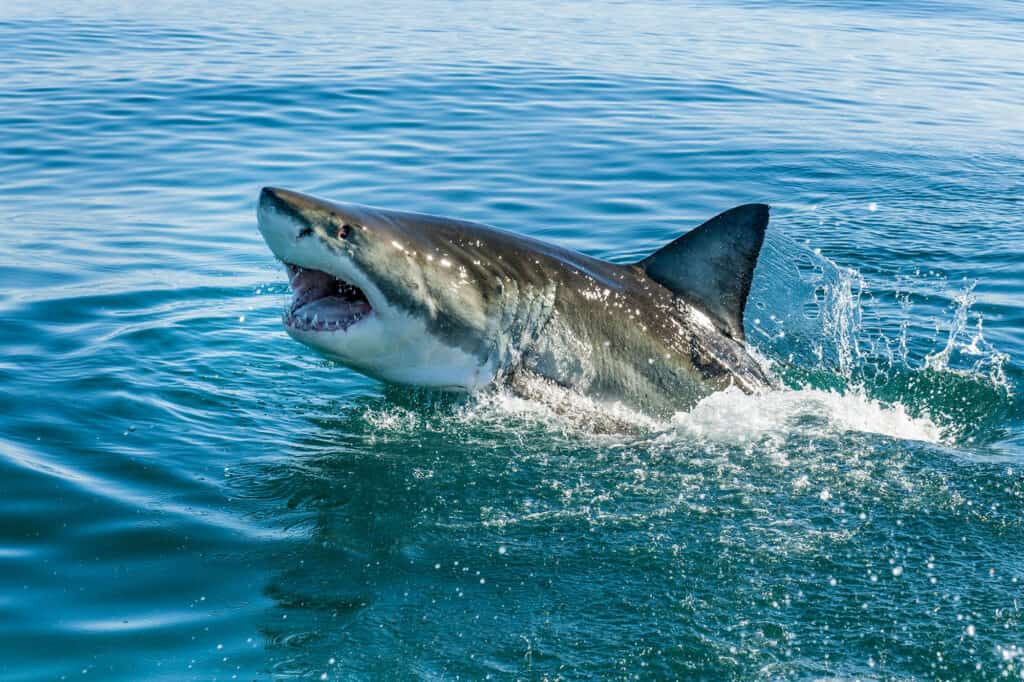
Breaching may be done by great whites to catch fast-moving prey.
©iStock.com/ELizabethHoffmann
What is the Biggest Great White Shark Ever Found?
Great white sharks are the largest predatory fish on the planet. They grow between 10 to 20 feet ( 3 to 6 meters) in length and weigh 1,500 to 5,000 pounds (680.3 to 2267 kg). These sharks live for around 70 years, and they never stop growing. However, their growth rate significantly decreases once they reach full maturity at around 20 to 30 years.
In 2014 a female shark was spotted and filmed for the tv series Shark Week. She was named ‘Deep Blue’ and is estimated to be about 50 years old. This large shark weighed about 4,500 pounds (2041 kg) and measured 20 feet (6 meters). When discovered, scientists believed she was pregnant due to her already astounding size.
When sharks like this are found and can be observed, it can help scientists understand what optimal conditions are for sharks to grow to such immense sizes. Observing sharks accurately and researching sharks is important in understanding their effect on the health of our oceans. Dozens of organizations have been created to help conserve great white sharks to help keep our ocean’s ecosystem healthy.
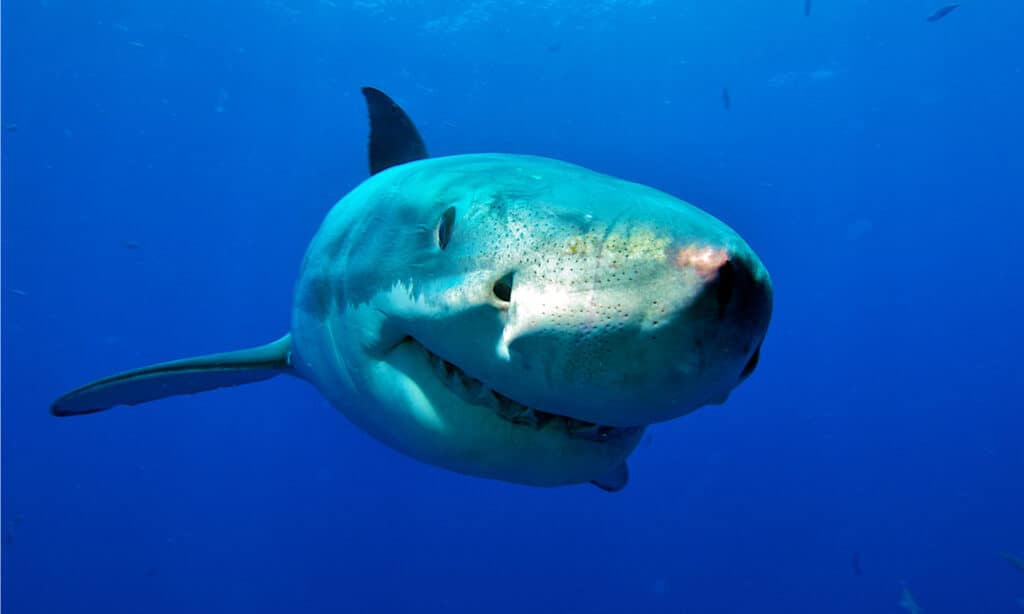
“Deep Blue” was the name given to the
great white shark
featured in the 2014 tv series Shark Week.
©Stefan Pircher/Shutterstock.com
Why are Great White Sharks Endangered?
Over the past few decades, great white sharks have been hunted for their fins and teeth, and they are also hunted for sports fishing and killed as trophies. Because of this, their population has seen an 80% decline in North America over the past 15 years. The great white species has been listed as a vulnerable species, so endangerment is possible if poaching and illegal fishing of these animals prevail.
The great white shark is an apex predator in the ocean that helps keep the ocean’s ecosystem balanced. Other fish species are also likely to go extinct if this predator goes extinct, and this is because the main prey for great whites is sea mammals like seals, who are known for overeating. If animals like seals are left unchecked, some species of fish will likely rapidly decline in population.
What are the Biggest Sharks That Live In Canada’s Oceans?

The
basking shark
‘s most impressive feature is its mouth, which opens up to 1 meter wide.
©Martin Prochazkacz/Shutterstock.com
The basking shark is the largest shark that lives off Canada’s coast but is an extremely rare sight to see. Basking sharks are one of the largest sharks in the ocean. They weigh up to 11,000 lbs (4989.5 kg) and grow between 20 to 26 feet (6 to 7.9 meters) long. They have a dull gray coloring, with gaping mouths that open 3 feet wide.
Luckily these large sharks are not predators but use their large gaping mouths to feed on plankton in the water. This shark swims through the water, catching plankton and filtering them with the gill rakers in their gill slits.
Basking sharks are the largest in Canada’s ocean but are rarely seen. The spring and summer months are when they migrate into the British Columbia’s ocean for breeding. This shark is rare in Canada’s oceans and is more common in the northern hemisphere.
What Other Sharks Swim Around Canada’s Coast?
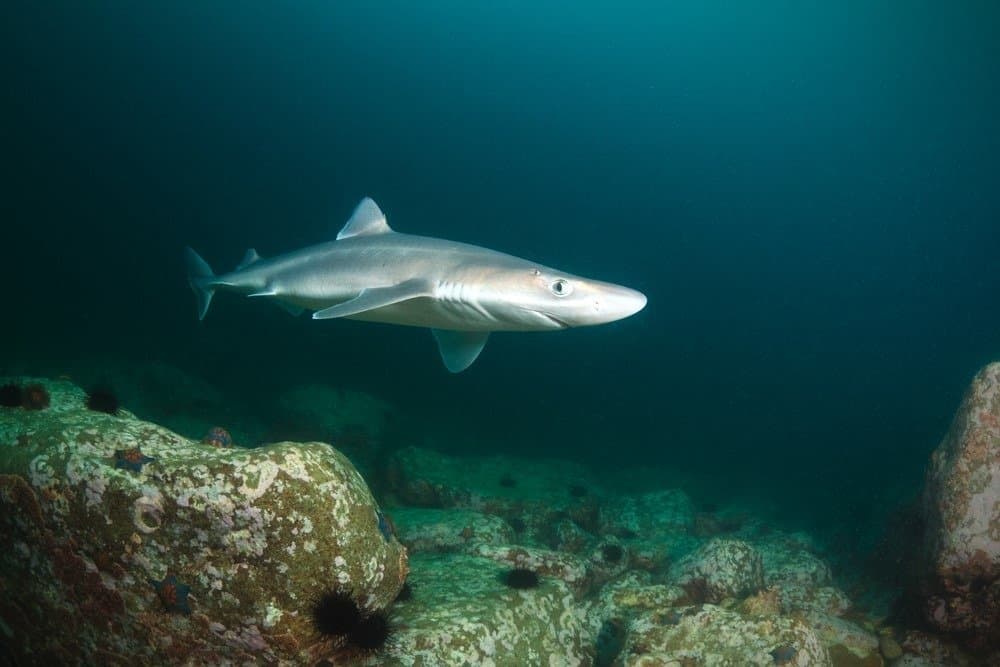
The shortfin mako and the deepwater catshark are some shark species commonly seen along Canada’s Coast.
©Boris Pamikov/Shutterstock.com
Canada has three oceans on its borders, so many sharks have been spotted nearby. Some species of shark that are commonly seen along Canada’s coast are;
- Spiny Dogfish
- Blue Shark
- Common Thresher
- Tope
- Bluntnose Sixgill
- Shortfin Mako
- Greenland Shark
- Porbeagle Shark
- Deepwater Catshark
- Basking Shark
- Bluntnose Sixgill Shark
- Pacific Sleeper Shark
- Salmon Shark
The photo featured at the top of this post is © Fiona Ayerst/Shutterstock.com
Thank you for reading! Have some feedback for us? Contact the AZ Animals editorial team.






